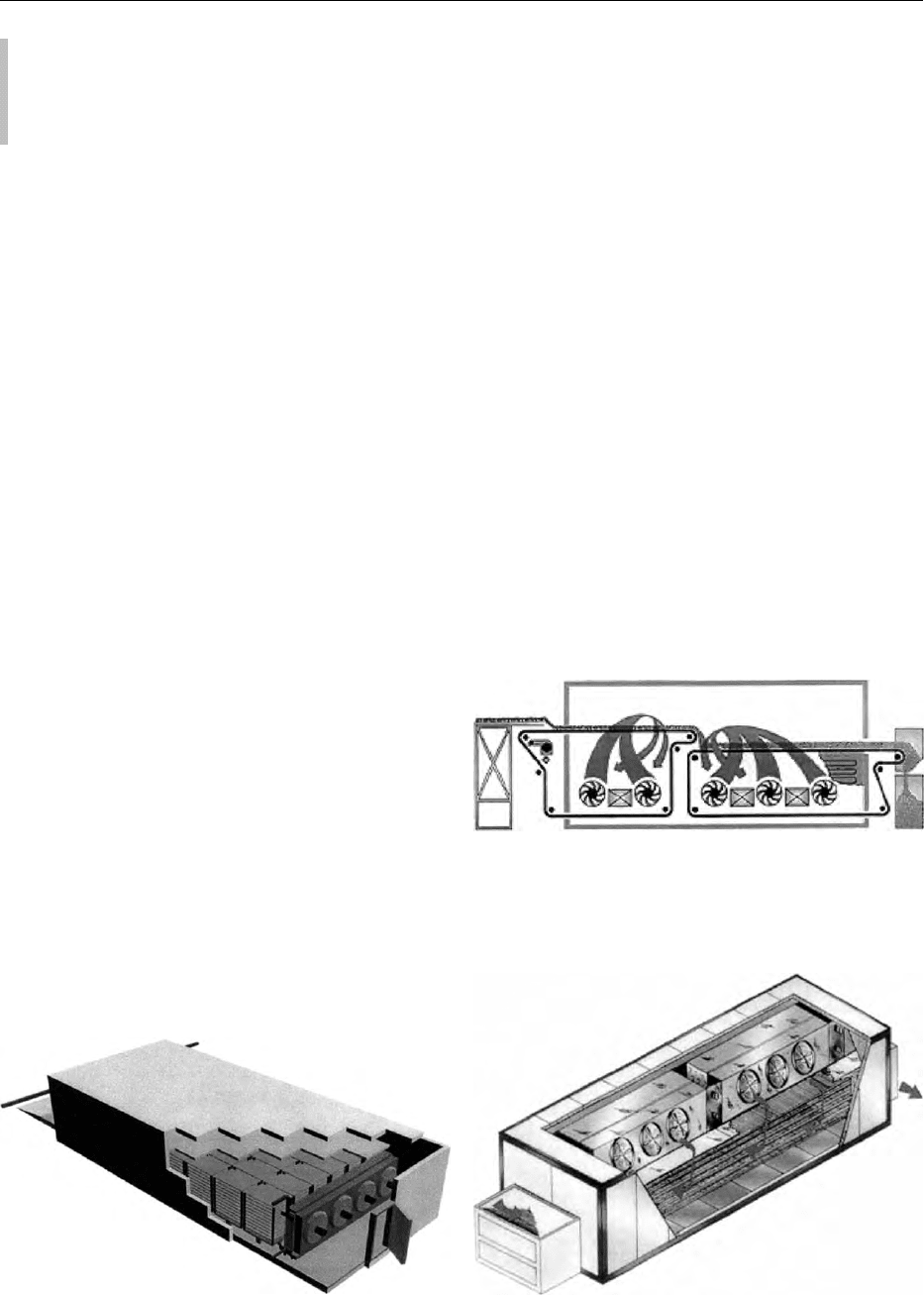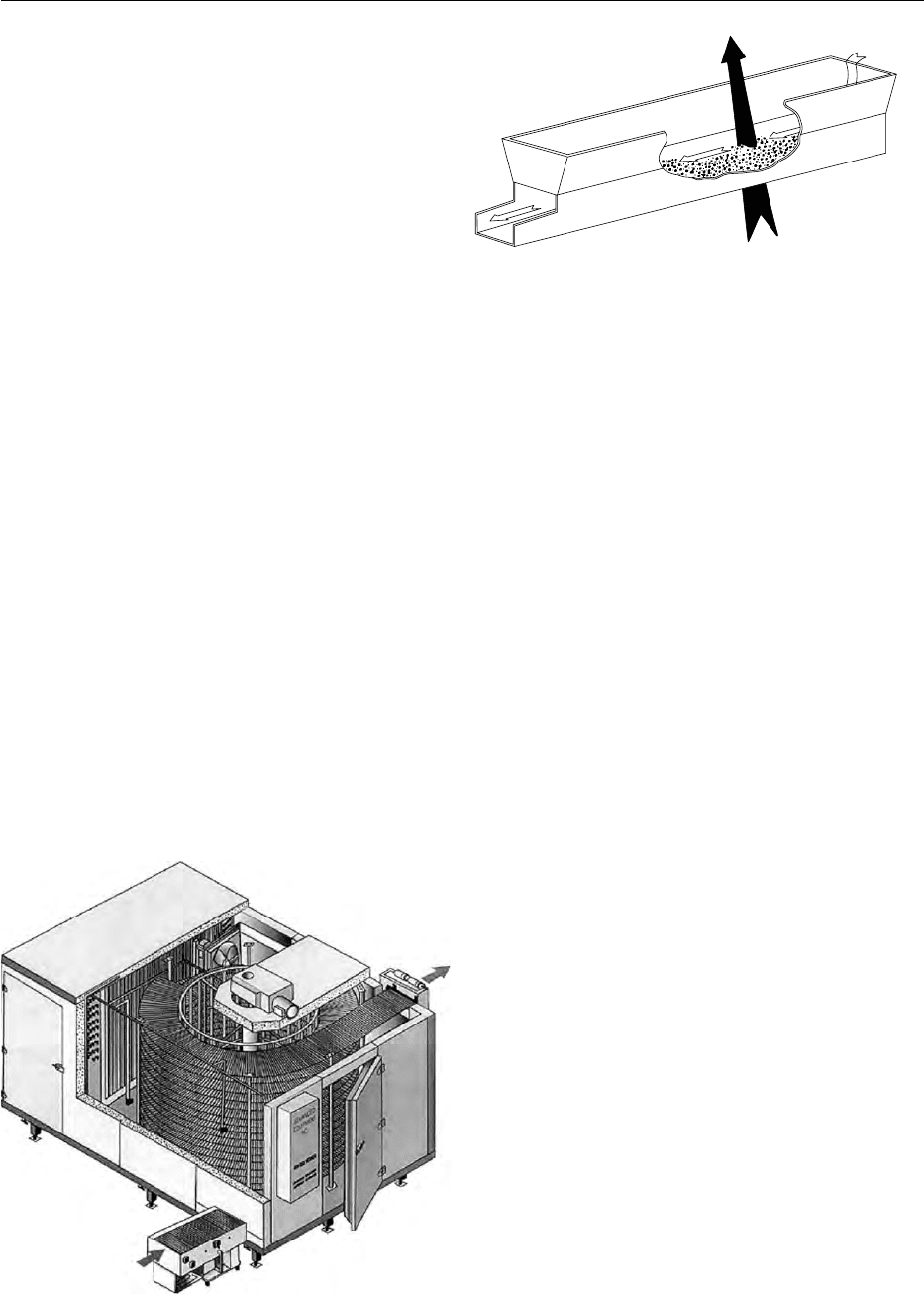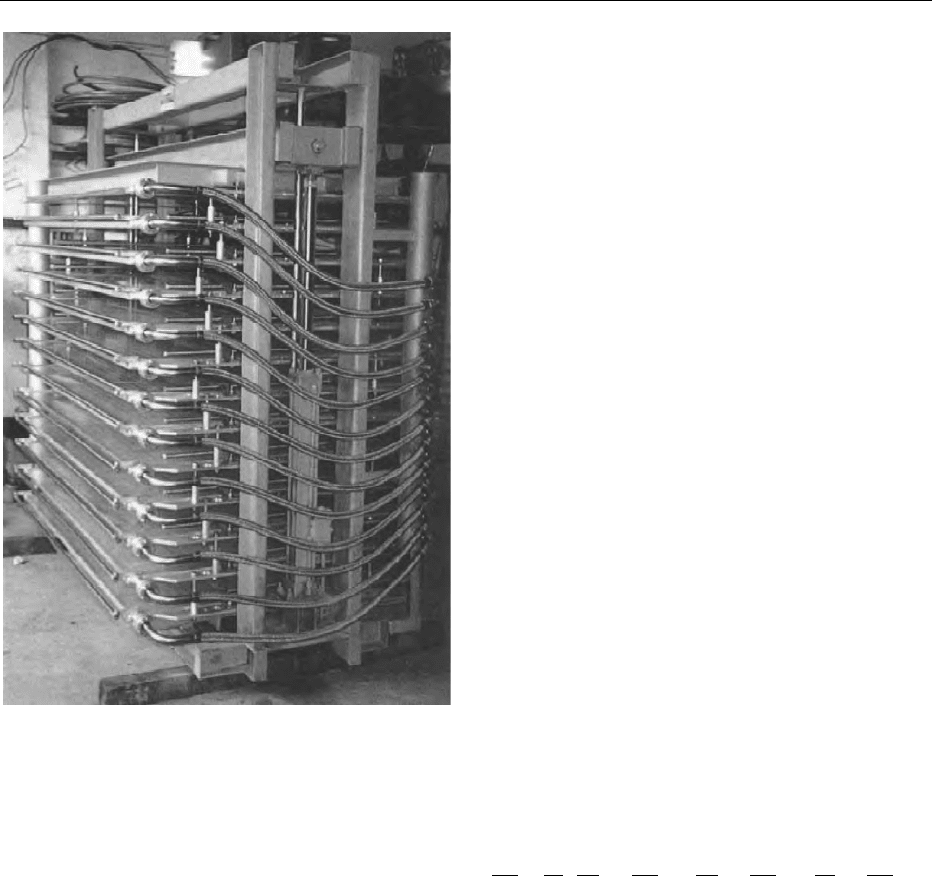Caballero B. (ed.) Encyclopaedia of Food Science, Food Technology and Nutrition. Ten-Volume Set
Подождите немного. Документ загружается.


0012 During a convective heat transfer process, energy is
theoretically transferred by convection alone. How-
ever, in practice, conduction, radiation, and mass
transfer may also occur at the same time. In blast
cooling/freezing operations, the conductive heat
transfer component is usually very small and can be
neglected. The significance of the radiation heat
transfer and evaporative cooling due to mass transfer
must be considered on an individual basis, and their
effects upon the total heat transfer must be properly
incorporated. Researchers often define an ‘effective’
heat transfer coefficient, which includes the effects of
convection and radiation heat transfer, as well as the
energy transfer due to evaporation of moisture from
the surface of the food item.
Thermal Properties of Foods
0013 The thermal properties of foods are important in the
design of food storage and refrigeration equipment as
well as in the estimation of process times for refriger-
ating, freezing, heating, or drying of foods. Because
the thermal properties of foods are strongly depend-
ent upon chemical composition and temperature, the
most viable option is to predict these thermal proper-
ties using mathematical models that account for the
effects of chemical composition and temperature.
0014Composition data for foods are readily available in
the literature. These data consist of the mass fractions
of the major food components: water, protein, fat,
carbohydrate, fiber, and ash. Food thermal properties
can be predicted by using these composition data in
conjunction with temperature-dependent mathemat-
ical models of the thermal properties of the individual
food components.
0015Equations for predicting the thermal properties of
these food components have been developed as func-
tions of temperature in the range of 40 to 150
C.
These equations are presented in Table 1. Because
water is the predominant constituent in most food
items, the water content of food items significantly
influences the thermophysical properties of foods.
Therefore, equations for predicting the thermal prop-
erties of water and ice have also been developed.
These equations are presented in Table 2.
0016In general, the thermophysical properties of a food
item are well behaved when the temperature of the
food item is above its initial freezing point. However,
tbl0001 Table 1 Thermal property equations for food components (40
C t 150
C)
Thermalproperty Food component Thermalproperty model
Thermal conductivity (W m
1
K
1
) Protein k ¼1.7881 10
1
þ1.1958 10
3
t 2.7178 10
6
t
2
Fat k ¼1.8071 10
1
2.7604 10
3
t 1.7749 10
7
t
2
Carbohydrate k ¼2.0141 10
1
þ1.3874 10
3
t 4.3312 10
6
t
2
Fiber k ¼1.8331 10
1
þ1.2497 10
3
t 3.1683 10
6
t
2
Ash k ¼3.2962 10
1
þ1.4011 10
3
t 2.9069 10
6
t
2
Density (kg m
3
) Protein r ¼1.3299 10
3
5.1840 10
1
t
Fat r ¼9.2559 10
2
4.1757 10
1
t
Carbohydrate r ¼1.5991 10
3
3.1046 10
1
t
Fiber r ¼1.3115 10
3
3.6589 10
1
t
Ash r ¼2.4238 10
3
2.8063 10
1
t
Specific heat (J kg
1
K
1
) Protein c
p
¼2.0082 10
3
þ1.2089t 1.3129 10
3
t
2
Fat c
p
¼1.9842 10
3
þ1.4733t 4.8008 10
3
t
2
Carbohydrate c
p
¼1.5488 10
3
þ1.9625t 5.9399 10
3
t
2
Fiber c
p
¼1.8459 10
3
þ1.8306t 4.6509 10
3
t
2
Ash c
p
¼1.0926 10
3
þ1.8896t 3.6817 10
3
t
2
tbl0002 Table 2 Thermal property equations for water and ice (40
C t 150
C)
Thermal property Thermalproperty model
Water Thermal conductivity (W m
1
K
1
) k
w
¼5.7109 10
1
þ1.7625 10
3
t 6.7036 10
6
t
2
Density (kg m
3
) r
w
¼9.9718 10
2
þ3.1439 10
3
t 3.7574 10
3
t
2
Specific heat (J kg
1
K
1
)
a
c
w
¼4.0817 10
3
5.3062t þ9.9516 10
1
t
2
Specific heat (J kg
1
K
1
)
b
c
w
¼4.1762 10
3
9.0864 10
2
t þ5.4731 10
3
t
2
Ice Thermal conductivity (W m
1
K
1
) k
ice
¼2.2196 6.2489 10
3
t þ1.0154 10
4
t
2
Density (kg m
3
) r
ice
¼9.1689 10
2
1.3071 10
1
t
Specific heat (J kg
1
K
1
) c
ice
¼2.0623 10
3
þ6.0769t
a
For the temperature range of 40 to 0
C.
b
For the temperature range of 0 to 150
C.
2708 FREEZING/Principles

below the initial freezing point, the thermophysical
properties of a food item vary dramatically with
temperature.
Specific Heat Capacity
0017 Specific heat capacity is a measure of the energy
transfer required to effect a temperature change and
can be used to calculate the heat load imposed on the
refrigeration equipment by the freezing of foods. In
unfrozen foods, specific heat capacity is relatively
constant with respect to temperature. However, for
frozen foods, there is a large decrease in specific heat
capacity as the temperature decreases.
Unfrozen
0018 The specific heat capacity of an unfrozen food item,
c
u
, can be obtained from the mass average of the
specific heat capacities of its components:
c
u
¼
X
c
i
w
i
, ð6 Þ
where the c
i
denotes the specific heat capacities of the
individual food components, and w
i
denotes their
mass fractions.
0019 If detailed composition data are not available, a
simpler equation for the specific heat capacity of an
unfrozen food item can be used:
c
u
¼ 4190 2300w
s
628w
3
s
, ð7 Þ
where c
u
is the specific heat capacity of the unfrozen
food item (J kg
1
K
1
), and w
s
is the mass fraction of
the solids in the food item.
Frozen
0020 Below the initial freezing point of the food item, the
sensible energy due to temperature change and
the latent energy due to the fusion of water must be
considered. Because latent heat is not released at a
constant temperature, but rather over a range of tem-
peratures, an apparent specific heat capacity can be
used to account for both the sensible and latent heat
effects. To develop expressions for apparent specific
heat capacity, first consider the specific enthalpy of a
frozen food. The specific enthalpies of the food con-
stituents are additive. Further, assume that the food is
composed of solids, liquid water, and ice. Then, the
specific enthalpy of the frozen food, h, can be mod-
eled as:
h ¼ h
s
w
s
þ h
w
w
w
þ h
ice
w
ice
, ð8 Þ
where h
s
is the specific enthalpy of the solid constitu-
ents, h
w
is the specific enthalpy of water, and h
ice
is
the specific enthalpy of ice. Differentiating eqn (8)
with respect to temperature at constant pressure
yields an expression for the apparent specific heat
capacity, c
a
:
c
a
¼
qh
qT
¼ c
s
w
s
þ c
w
w
w
þ c
ice
w
ice
þ h
w
qw
w
qT
þ h
ice
qw
ice
qT
,
ð9Þ
where c
s
is the specific heat capacity of the solid
constituents, c
w
is the specific heat capacity of
water, and c
ice
is the specific heat capacity of ice.
0021Assuming that high moisture content food items
can be modeled as ideal dilute solutions, and noting
that qw
w
/qT ¼qw
ice
/ qT, the following equation for
the apparent specific heat capacity of high moisture
content food items can be derived:
c
a
¼ c
u
þ w
b
w
wo
ðÞc þ Ew
s
RT
2
o
M
w
t
2
0:8c
, ð10Þ
where Dc is the difference between the specific heat
capacities of water and ice ( Dc ¼ c
w
c
ice
), E is the
ratio of the molar masses of water, M
w
, and food
solids, M
s
,(E ¼ M
w
/M
s
), R is the ideal gas constant,
T
o
is the freezing point of water (T
o
¼ 273.2 K), and
t is the food temperature (
C).
0022A slightly simpler apparent specific heat capacity
equation, which is similar in form to that of eqn (10),
is given as follows:
c
a
¼ 1550 þ 1260w
s
þ
w
s
RT
2
o
M
s
t
2
:ð11Þ
Specific Enthalpy
0023The change in specific enthalpy of a food item can be
used to estimate the energy that must be removed
from a food item in order to effect a temperature
change. Above the freezing point, specific enthalpy
consists of sensible energy, whereas below the initial
freezing point, specific enthalpy consists of both sens-
ible and latent energy.
0024Specific enthalpy may be obtained from the defin-
ition of the constant pressure specific heat capacity:
c
p
¼
qh
qT
p
, ð12Þ
where c
p
is the constant pressure specific heat cap-
acity, h is the specific enthalpy, and T is temperature.
Equations for specific enthalpy may be obtained by
integrating expressions of specific heat capacity with
respect to temperature.
Unfrozen
0025The specific enthalpy of an unfrozen food item, h,
may be determined by integrating eqn (6) as follows:
FREEZING/Principles 2709

h ¼
X
h
i
w
i
¼
X
ð
c
i
,w
i
dT, ð13Þ
where h
i
is the specific enthalpy of the individual
food components, and w
i
is the mass fraction of
the food components.
002 6 Integration of eqn (7) from the initial freezing point
of a food item, t
f
, to a temperature, t, above the
freezing point would yield:
h ¼ðt t
f
Þð4190 2300w
s
628w
3
s
Þ:ð14Þ
This equation, however, would predict zero specific
enthalpy at the initial freezing point of the food item,
t
f
. Typically, in the literature for food refrigeration,
the reference temperature for zero specific enthalpy is
40
C. Thus, in order to make eqn (14) consistent
with zero specific enthalpy at 40
C, an additional
term must be added to eqn (14), namely, the specific
enthalpy at the initial freezing point, h
f
:
h ¼ h
f
þðt t
f
Þð4190 2300w
s
628w
3
s
Þ:ð15Þ
The specific enthalpy at the initial freezing point, h
f
,
may be estimated by evaluating eqn (17) at the initial
freezing temperature of the food, as discussed below.
Frozen
002 7 Integration of eqn (10) between a reference tempera-
ture, T
r
, and the food temperature, T, leads to the
following expression for the specific enthalpy of a
frozen food:
h ¼ðT T
r
Þ c
u
þðw
b
w
wo
Þc
þ Ew
s
RT
2
o
M
w
ðT
o
T
r
ÞðT
o
T Þ
0 :8 c
:
ð16Þ
Generally, the reference temperature, T
r
, is taken to
be 233.2 K ( 40
C) at which point the enthalpy is
defined to be zero.
002 8 By integrating eqn (11) between a reference
temperature, T
r
, and the food temperature, T, the
following expression for specific enthalpy below
the initial freezing point may be obtained:
h ¼ðt t
r
Þ 1500 þ 1260w
s
, þ
w
s
RT
2
o
M
s
tt
r
:ð17Þ
Thermal Conductivity
002 9 Thermal conductivity is the material property that
relates the conduction heat transfer rate to the tem-
perature gradient. The thermal conductivity of a food
item depends upon many factors, including the com-
position, structure, and temperature of the food item.
0030Early work in the modeling of food thermal con-
ductivity includes an adaption of Maxwell’s equation.
This model is based upon the thermal conductivity of
dilute dispersions of small spheres in a continuous
phase:
k ¼ k
c
1 ½1 aðk
d
=k
c
Þb
1 þða 1Þb
, ð18Þ
where k is the conductivity of the mixture, k
c
is the
conductivity of the continuous phase, k
d
is the con-
ductivity of the dispersed phase, a ¼ 3k
c
/(2k
c
þ k
d
),
b ¼ V
d
/(V
c
þ V
d
), V
d
is the volume of the dispersed
phase, and V
c
is the volume of the continuous phase.
0031In an effort to account for the different structural
features of foods, thermal conductivity models for
both homogeneous and fibrous food items have
been developed. The differences in thermal conduct-
ivity parallel and perpendicular to the food fibers are
taken into account in these fibrous food thermal
conductivity models.
0032For an isotropic, homogeneous two-component
system composed of continuous and discontinuous
phases, in which the thermal conductivity is inde-
pendent of the direction of heat flow, the following
expression may be used to determine thermal con-
ductivity, k:
k ¼ k
c
1 L
2
1 L
2
ð1 LÞ
, ð19Þ
where k
c
is the thermal conductivity of the continuous
phase, and L
3
is the volume fraction of the discon-
tinuous phase. In eqn (19), it is assumed that the
thermal conductivity of the continuous phase is
much larger than the thermal conductivity of
the discontinuous phase.
0033For an anisotropic, fibrous two-component system
in which the thermal conductivity is dependent upon
the direction of heat flow, two expressions for ther-
mal conductivity have been developed. For heat flow
that is parallel to the food fibers, the following
expression may be used to determine thermal con-
ductivity, k
k
:
k
jj
¼ k
c
1 N
2
1
k
d
k
c
, ð20Þ
where N
2
is the volume fraction of the discontinuous
phase in the fibrous food product. If the heat flow
is perpendicular to the food fibers, the following
expression for thermal conductivity, k
?
, applies:
k
?
¼ k
c
1 P
1 Pð1 NÞ
, ð21Þ
where P ¼ N(1 k
d
/k
c
).
2710 FREEZING/Principles

0034 For multicomponent systems, numerous research-
ers have proposed the use of parallel and perpendicu-
lar (or series) thermal conductivity models based
upon analogies with electrical resistance. The parallel
model is simply the sum of the thermal conductivities
of the food constituents multiplied by their volume
fractions:
k ¼
X
n
i¼1
i
k
i
, ð 22Þ
where f
i
is the volume fraction of constituent i. The
volume fraction of constituent i can be found from
the following equation:
i
¼
w
i
i
P
n
j¼1
w
j
j
: ð23Þ
The perpendicular model is the reciprocal of the
sum of the volume fractions divided by their thermal
conductivities:
k ¼
1
P
n
i¼1
i
k
i
: ð24Þ
These two models have been found to predict the
upper and lower bounds of the thermal conductivity
of most food items.
See also: Heat Transfer Methods
Further Readings
Becker BR and Fricke BA (1999) Evaluation of semi-analyt-
ical/empirical freezing time estimation methods, Part I:
Regularly shaped food items. International Journal of
Heating, Ventilating, Air-Conditioning, and Refrigerat-
ing Research 5: 151–169.
Becker BR and Fricke BA (1999) Evaluation of semi-analyt-
ical/empirical freezing time estimation methods, Part II:
Irregularly shaped food items. International Journal of
Heating, Ventilating, Air-Conditioning, and Refrigerat-
ing Research 5: 171–187.
Becker BR and Fricke BA (1999) Freezing times of regularly
shaped food items. International Communications in
Heat and Mass Transfer 26: 617–626.
Becker BR and Fricke BA (1999) Food thermophysical
property models. International Communications in
Heat and Mass Transfer 26: 627–636.
Becker BR, Misra A and Fricke BA (1996) Bulk refriger-
ation of fruits and vegetables, Part I: theoretical consid-
erations of heat and mass transfer. International Journal
of Heating, Ventilating, Air-Conditioning, and Refriger-
ating Research 2: 122–134.
Becker BR, Misra A and Fricke BA (1996) Bulk refriger-
ation of fruits and vegetables, Part II: Computer algo-
rithm for heat loads and moisture loss. International
Journal of Heating, Ventilating, Air-Conditioning, and
Refrigerating Research 2: 215–230.
Chen CS (1985) Thermodynamic analysis of the freezing
and thawing of foods: Enthalpy and apparent specific
heat. Journal of Food Science 50: 1158–1162.
Choi Y and Okos MR (1986) Effects of temperature and
composition on the thermal properties of foods. In:
LeMaguer M and Jelen P (eds) Food Engineering and
Process Applications, vol. 1, pp. 93–101. London:
Elsevier Applied Science.
Eucken A (1940) Allgemeine Gesetzmassigkeiten fur das
Warmeleitvermogen verschiedener Stoffarten und Agg-
regatzustande. Forschung auf dem Gebiete des Inge-
nieurwesens, Ausgabe A 11: 6.
Franks F (1982) The properties of aqueous solutions at
subzero temperatures. In: Water: A Comprehensive
Treatise, vol. 7, pp. 215–338. New York: Plenum.
Franks F, Asquith MH, Hammond CC, Skaer H leB and
Echlin P (1977) Polymeric cryoprotectants in the preser-
vation of biological ultrastruture, I: Low temperature
states of aqueous solutions of hydrophilic polymers.
Journal of Microscopy 110: 223–238.
Fricke BA and Becker BR (2001) Evaluation of thermophy-
sical property models for foods. International Journal of
Heating, Ventilating, Air-Conditioning and Refrigerat-
ing Research 7: 311–330.
Holland B, Welch AA, Unwin ID et al. (1991) McCance and
Widdowson’s – The Composition of Foods. Cambridge,
UK: Royal Society of Chemistry and Ministry of Agri-
culture, Fisheries and Food.
Kopelman I (1966) Transient Heat Transfer and Thermal
Properties in Food Systems. PhD thesis. Michigan State
University. East Lansing, MI.
MacKenzie AP (1977) Freezing behaviour of aqueous solu-
tions. Philosophical Transactions of the Royal Society of
London B 278: 167–189.
Murakami EG and Okos MR (1989) Measurement and
prediction of thermal properties of foods. In: Singh
RP and Medina AG (eds) Food Properties and
Computer-aided Engineering of Food Processing
Systems pp. 3–48. Dordrecht: Kluwer Academic.
Schwartzberg HG (1976) Effective heat capacities for the
freezing and thawing of food. Journal of Food Science
41: 152–156.
Slade L and Levine H (1988) Non-equilibrium behavior of
small carbohydrate–water systems. Pure and Applied
Chemistry 60: 1841–1864.
Tchigeov G (1979) Thermophysical Processes in Food
Refrigeration Technology. Moscow: Food Industry.
USDA (1996) Nutrient Database for Standard Reference,
Release 11. Washington, DC: US Department of
Agriculture.
FREEZING/Principles 2711

Operations
B R Becker and B A Fricke, University of Missouri-
Kansas City, Kansas City, MO, USA
Copyright 2003, Elsevier Science Ltd. All Rights Reserved.
Introduction
0001 Freezing operations can be grouped by their basic
method of extracting heat from foods. Blast freezing
utilizes convection heat transfer to remove heat from
foods while contact freezing makes use of conduction
heat transfer to remove energy from foods. Cryogenic
freezing may utilize convection and/or conduction
heat transfer to remove heat from foods.
Blast Freezers
0002 Blast freezers use air as the heat transfer medium and
depend on contact between the product and the air.
Sophistication in air flow control and conveying tech-
niques varies from crude blast freezing chambers to
carefully controlled impingement-style freezers. (See
Freezing: Blast and Plate Freezing.)
Blast-Cell Freezer
0003 The blast-cell freezer, shown in Figure 1, is the sim-
plest design and consists of an insulated enclosure
equipped with refrigeration coils and fans that circu-
late the air over the food items in a controlled way.
Products are placed on trays, which are then placed
into racks in such a way that an air space is left be-
tween adjacent layers of trays. The racks are moved in
and out of the tunnel manually. Almost all products
may be frozen either individually or in cartons in a
blast-cell freezer. Because labor requirements are rela-
tively high and product flow is cumbersome, blast-
cell freezers are suitable for small quantities of varied
products.
Straight-Belt Freezer
0004The straight-belt freezer, shown in Figure 2, utilizes a
wire mesh belt conveyor in a blast room, which pro-
vides continuous product flow. Vertical air flow is
used, which forces cold air up through the product
layer, thereby creating good contact between the air
and the product. Straight-belt freezers are generally
used with fruits, vegetables, French fried potatoes,
cooked meat toppings (e.g., diced chicken), and
cooked shrimp.
0005Straight-belt freezers usually incorporate a two-
stage belt composed of two mesh conveyor belts in
series. The first stage initially precools or crust-freezes
the outer layer of the product before it is transferred
to the second stage for final freezing and sensible
cooling to 18
C or below. Freezing times range
from 3 to 50 min.
0006For products with longer freezing times or higher
capacity requirements, the freezer footprint can be
reduced by stacking belts above each other to form
a multipass system, as shown in Figure 3. However,
this type of freezing system has the potential for prod-
uct damage and jams at the belt transfers.
fig0001 Figure 1 Blast-cell freezer (Ingvar).
fig0003Figure 3 Multipass belt freezer (Advanced Equipment, Inc.).
fig0002Figure 2 Straight-belt freezer (Advanced Equipment, Inc.).
2712 FREEZING/Operations

Spiral-Belt Freezer
0007 The spiral-belt freezer, shown in Figure 4, is often
used for products that require gentle handling or a
long freezing time (generally 10 min to 3 h). This
freezer consists of an endless conveyor belt that is
wrapped cylindrically, one tier above or below the
last, to form a configuration which requires minimal
floor space for a relatively long belt. The number of
tiers in the spiral can be varied to accommodate dif-
ferent capacities and two or more spiral towers can be
used in series for products with long freezing times.
Modular and field-erected spiral freezers are avail-
able in a range of belt widths and lengths to accom-
modate various upstream processes and capacity
requirements.
0008 In spiral freezers, horizontal air flow is usually
supplied by axial fans mounted along one side of the
spiral which blow air horizontally across the spiral
conveyor. Some freezers incorporate more sophisti-
cated air flow control utilizing extensive baffling
and high-pressure fans.
0009 Typical products frozen in spiral-belt freezers in-
clude raw and cooked meat patties, fish fillets, chicken
portions, pizza, and a variety of packaged products.
Fluidized-Bed Freezers
0010 The fluidized-bed freezer, shown in Figure 5, utilizes
air for product transport and heat transfer. The high
degree of fluidization improves the heat transfer rate
and is well suited for small, uniform-sized particulate
products such as peas, resulting in a freezing time of
3–11 min.
Fluidized-Belt Freezers
0011The fluidized-belt freezer is a hybrid of the belt and
fluidized-bed freezers which incorporates a fluidizing
section in the first belt stage. It is designed to provide
fluidizing conditions for wet incoming product with a
belt to assist the transport of heavier products that do
not fluidize fully. Once crust-frozen, the product can
be loaded deeper for greater efficiency on the second
belt.
Contact Freezers
0012Contact freezers utilize conduction heat transfer
whereby the product or package is placed in direct
contact with a refrigerated surface. (See Freezing:
Blast and Plate Freezing.)
Plate Freezers
0013The most common type of contact freezer is the plate
freezer, in which the product is pressed between metal
plates, as shown in Figure 6. Refrigerant is circulated
inside channels in the plates, insuring efficient heat
transfer and short freezing times. Plate freezers are
especially suited for products that are good conduct-
ors of heat, such as fish fillets, chopped spinach, or
meat offal. The plate freezer’s heat transfer advantage
is reduced with increasing product thickness, which is
often limited to 5–8 cm.
0014For packaged products, an additional advantage of
plate freezers is that pressure from the plates minim-
izes any bulging that may occur during freezing,
resulting in packages that are even and square. How-
ever, packages or cavities should be well filled to
insure efficient freezing.
0015Contact plate freezers are available in horizontal or
vertical arrangements with manual loading and
unloading. Horizontal plate freezers are also avail-
able with automatic loading and unloading, resulting
in higher capacities and continuous operation. Auto-
matic plate freezers can accommodate up to 200
packages per minute, with freezing times from 10 to
150 min.
Product flow
Air flow
fig0005Figure 5 Fluidized-bed freezer (ASHRAE).
fig0004 Figure 4 Spiral-belt freezer (Advanced Equipment, Inc.).
FREEZING/Operations 2713

Specialized Contact Freezers
001 6 A combination of air and contact freezing is often
used for wet fish fillets and similar soft, wet products
with relatively large, flat surfaces. The product is
placed on to a continuous, solid stainless-steel belt
and freezing is usually accomplished both by conduc-
tion through the belt to a cooling medium below the
belt and by convection through controlled air flow
above the belt. Another specialized contact freezer
conveys food products on a continuous plastic film
over a low-temperature refrigerated plate, thus elim-
inating product deformation or wire mesh belt mark-
ings on products which are flat, wet, and sticky, soft,
or in need of hand-shaping before freezing. These
freezer designs produce attractive product, but a
drawback is the physical size of the freezer. Freezing
times of less than 30min can be achieved with these
types of freezer.
Cryogenic Freezers
001 7 Cryogenic freezers use liquid nitrogen or liquid
carbon dioxide as the refrigeration medium, and the
freezers may be batch cabinets, straight-belt freezers,
spiral conveyors, or liquid immersion freezers. While
cryogenic freezers represent a low initial investment,
they have a high operating cost. Consequently, cryo-
genic freezing is often utilized for small-scale produc-
tion, new products, overload situations, or seasonal
products.
0018The most common type of cryogenic freezer is a
straight-through, single-belt tunnel. Liquid nitrogen
at 196
C or carbon dioxide at 79
C is introduced
at the outfeed end of the freezer, directly on to the
product. As the liquid nitrogen or carbon dioxide
vaporizes, the cold vapors are circulated toward the
infeed end, where they are used for precooling and
initial freezing of the product. The warmed vapors
(typically 45
C) are then discharged to the atmos-
phere. The low temperature of the liquid and vapor-
ous nitrogen or carbon dioxide provides rapid
freezing, which can improve quality and reduce dehy-
dration for some products. However, the freezing cost
ishigh,andthesurfaceofproductshavingahighwater
content may crack if precautions are not taken. (See
Freezing: Cryogenic Freezing.)
Freezing Time Estimation Methods
0019In order for food freezing operations to be cost-
effective, it is necessary to design the refrigeration
equipment optimally to fit the specific requirements
of the particular freezing application. This requires
estimation of the freezing times of foods, as well as
the corresponding refrigeration loads.
0020Theoretically, the freezing of foods can be de-
scribed via the Fourier heat conduction equation:
@T
@t
¼
1
c
@
@x
k
@T
@x
þ
@
@y
k
@T
@y
þ
@
@z
k
@T
@z
ð1Þ
where T is temperature, t is time, r is the density of
the food, c is the specific heat of the food, k is the
thermal conductivity of the food, and x, y, and z are
the coordinate directions. For ideal, regularly shaped
food items with constant thermophysical properties,
uniform initial conditions, constant external condi-
tions, and a prescribed surface temperature or a
convection boundary condition, exact analytical so-
lutions for eqn (1) exist which allow for the estima-
tion of the freezing times of foods. However, for
realistic freezing processes, the food items are gener-
ally irregularly shaped with temperature-dependent
thermophysical properties and therefore it is not pos-
sible to derive exact analytical solutions for the freez-
ing times of foods.
0021As a result of this difficulty, most of the research
effort has been in the development of semianalytical/
fig0006 Figure 6 Plate freezer (Ingvar).
2714 FREEZING/Operations

empirical food freezing time prediction methods
which make use of various simplifying assumptions.
Numerous such methods have been proposed, and the
designer is thus faced with the challenge of selecting
an appropriate estimation method from the plethora
of available methods.
0022 In the following section, the basic freezing time
estimation method developed by Plank is discussed
first, followed by a discussion of those methods which
are based upon modifications of Plank’s equation.
The discussion then focuses on those freezing time
estimation methods in which the freezing time is cal-
culated as the sum of the precooling, phase change,
and subcooling times. The last section deals with
freezing time estimation methods which account for
irregularly shaped food items.
Plank’s Equation
0023 The most widely known method for estimating the
freezing times of foods was developed by R. Plank in
1913. In this method, it is assumed that only convect-
ive heat transfer occurs between the food item and the
surrounding cooling medium. In addition, it is as-
sumed that the food item is at its initial freezing
temperature and that this temperature is constant
throughout the freezing process. Furthermore, a con-
stant thermal conductivity for the frozen region is
assumed. Plank’s freezing time estimation method is
given as follows:
t ¼
L
f
T
f
T
m
PD
h
þ
RD
2
k
s
ð2Þ
where L
f
is the volumetric latent heat of fusion, T
f
is
the initial freezing temperature of the food, T
m
is the
freezing medium temperature, D is the thickness of
the slab or the diameter of the sphere or infinite
cylinder, h is the convective heat transfer coefficient,
k
s
is the thermal conductivity of the fully frozen
food, and P and R are geometric factors. For the
infinite slab, P ¼
1
2
and R ¼
1
8
. For a sphere, P and R
are
1
6
and
1
24
, respectively, and for an infinite cylinder,
P ¼
1
4
and R ¼
1
16
.
0024 The geometric factors, P and R, provide insight as
to the effect of shape upon freezing time. Plank’s
shape factors indicate that an infinite slab of thickness
D, an infinite cylinder of diameter D and a sphere of
diameter D, if exposed to the same conditions, would
have freezing times in the ratio of 6:3:2. Hence, a
cylinder will freeze in half the time of a slab and a
sphere will freeze in one-third the time of a slab.
0025 Various researchers have noted that Plank’s
method does not accurately predict the freezing
times of foods because it assumes that freezing of
foods takes place at a constant temperature, and not
over a range of temperatures, as is the case in actual
food freezing processes. In addition, the thermal con-
ductivity of the frozen food is assumed to be constant,
but in reality, the thermal conductivity varies greatly
during freezing. Another limitation of Plank’s equa-
tion is that it neglects the removal of sensible heat
above the freezing point. Furthermore, Plank’s
method is only applicable to infinite slabs, infinite
cylinders, and spheres. Researchers have subse-
quently focused upon development of improved
freezing time estimation methods which account for
precooling and subcooling times, nonconstant ther-
mal properties, irregular geometries, and phase
change over a range of temperatures.
Modifications to Plank’s Equation
0026Modifications to Plank’s equation include corrections
to account for the removal of sensible heat both
above and below the initial freezing point of
the food as well as temperature variation during
freezing. Regression equations were developed to
estimate the geometric parameters, P and R, for infin-
ite slabs, infinite cylinders, and spheres. In these
regression equations, the effects of surface heat
transfer, precooling, and final subcooling are ac-
counted for by means of the Biot number, Bi, the
Plank number, Pk, and the Stefan number, Ste,
respectively.
0027The Biot number, Bi, is defined as follows:
Bi ¼
hD
k
ð3Þ
In the literature for freezing of foods, it is accepted
that the characteristic dimension, D, is defined as
twice the shortest distance from the thermal center
of a food item to its surface. For an infinite slab, D is
the thickness. For an infinite cylinder or a sphere, D
is the diameter. These definitions will be adopted for
this article, unless otherwise noted.
0028In general, the Plank number, Pk, is defined as
follows:
Pk ¼
C
l
ðT
i
T
f
Þ
H
ð4Þ
where C
l
is the volumetric specific heat of the un-
frozen phase and DH is the volumetric enthalpy
change of the food between T
f
and the final food
temperature. The Stefan number, Ste, is similarly de-
fined as follows:
Ste ¼
C
s
ðT
f
T
m
Þ
H
ð5Þ
where C
s
is the volumetric specific heat of the frozen
phase.
FREEZING/Operations 2715

0029 The freezing times of foods are then calculated with
a modified version of Plank’s equation. Plank’sori-
ginal geometric factors, P and R, are replaced with
the modified values given in Table 1, and the latent
heat, L
f
, in Plank’s equation is replaced with the
volumetric enthalpy change of the food, DH
10
, be-
tween the freezing temperature, T
f
, and the final
center temperature, assumed to be 10
C. As
shown in Table 1, the geometric factors P and R are
functions of the Plank number, Pk, and the Stefan
number, Ste. Both of these parameters should be
evaluated using the enthalpy change DH
10
. Thus,
the modified Plank equation takes the following
form:
t ¼
H
10
T
f
T
m
PD
h
þ
RD
2
k
s
ð6Þ
Precooling, Phase Change, and Subcooling Time
Calculations
0030 Numerous researchers have taken a different ap-
proach to account for the effects of sensible heat
removal above and below the initial freezing point.
In these methods, the total freezing time, t, is the sum
of the precooling, phase change, and subcooling
times:
t ¼ t
1
þ t
2
þ t
3
ð7Þ
where t
1
, t
2
, and t
3
are the precooling, phase change,
and subcooling times, respectively.
0031 An example of a freezing time estimation method
in which sensible heat effects are included by calcu-
lating precooling, phase change, and subcooling times
separately is given below. The use of a mean freezing
point, which is assumed to be 1.5 K below the initial
freezing point of the food, accounts for freezing
which takes place over a range of temperatures. The
freezing time estimation method is stated in terms of
the volume and surface area of the food item and is
therefore applicable to food items of any shape. This
method is given as:
t
i
¼
Q
i
hA
s
T
mi
1 þ
Bi
i
k
i
; i ¼ 1; 2; 3 ð8Þ
with the variables defined as shown in Table 2.
Geometric Considerations
0032Equivalent heat transfer dimensionality A geomet-
ric correction factor, called the equivalent heat trans-
fer dimensionality, E, was introduced to calculate the
freezing times of irregularly shaped food items. In this
method, the freezing time of an irregularly shaped
object, t
shape
, is related to the freezing time of an
infinite slab, t
slab
, via the equivalent heat transfer
dimensionality, E, as follows:
t
shape
¼
t
slab
E
ð9Þ
The freezing time of the infinite slab is then calculated
from one of the many suitable freezing time estima-
tion methods available for infinite slabs.
0033Expressions for determining the equivalent heat
transfer dimensionality of infinite slabs, infinite and
finite cylinders, rectangular bricks, spheres, and two-
and three-dimensional irregular shapes are given as
follows:
E ¼ G
1
þ G
2
E
1
þ G
3
E
2
ð10Þ
where:
E
1
¼ Xð2:32=
1:77
1
Þ
1
1
þ½1 Xð2:32=
1:77
1
Þ
0:73
2:50
1
ð11Þ
E
2
¼ Xð2:32=
1:77
2
Þ
1
2
þ½1 Xð2:32=
1:77
2
Þ
0:73
2:50
2
ð12Þ
tbl0001 Table 1 Expressions for P and R
Shape P and R expressions
Infinite slab
P ¼ 0:5072 þ 0:2018Pk þ Ste 0:3224Pk þ
0:0105
Bi
þ 0:0681
R ¼ 0:1684 þ Steð0:2740Pk 0:0135Þ{
Infinite cylinder P ¼ 0:3751 þ 0:0999Pk þ Ste 0:4008Pk þ
0:0710
Bi
0:5865
R ¼ 0:0133 þ Steð0:0415Pk þ 0:3957Þ{
Sphere P ¼ 0:1084 þ 0:0924Pk þ Ste 0:231Pk
0:3114
Bi
þ 0:6739
R ¼ 0:0784 þ Steð0:0386Pk 0:1694Þ{
2716 FREEZING/Operations

XðxÞ¼x =ðBi
1:34
þ xÞð13 Þ
and the geometric constants, G
1
, G
2
and G
3
, are
given in Table 3. The dimensional ratios, b
1
and b
2
,
are defined as follows:
1
¼
second shortest dimension of the food item
shortest dimension of the food item
ð14 Þ
2
¼
longest dimension of the food item
shortest dimension of the food item
ð15 Þ
0034 Mean conducting path Knowledge of the Biot
number of a food item is required to utilize freezing
time estimation methods. To calculate the Biot
number of a food item, its characteristic dimension
must be known. Because it is difficult to determine the
characteristic dimension of an irregularly shaped
food item, the concept of the mean conducting path
was introduced. The mean conducting path, D
m
/2, is
the mean heat transfer length from the surface of the
food item to its thermal center. This mean conducting
path is used to calculate the Biot number which, in
turn, is used in the calculation of the freezing time.
Thus, the Biot number becomes:
Bi ¼
hD
m
k
ð16Þ
where D
m
is twice the mean conducting path.
0035For rectangular blocks of food, the mean conduct-
ing path is proportional to the geometric mean of the
block’s two shorter dimensions. Based upon this
result, an equation to calculate the Biot number, Bi,
for rectangular blocks of food is given as follows:
Bi
Bi
o
¼ 1 þ 1 :5
ffiffiffiffiffi
1
p
1
hi
4
þ
1
1
þ
1
2
(
1 þ
4
Bi
o
4
)
0:25
ð17Þ
where Bi
o
is the Biot number based on the shortest
dimension of the block, D
1
: Bi
o
¼ hD
1
/k. The Biot
number, Bi, calculated with eqn (17) is then substi-
tuted into a freezing time estimation method, such as
eqn (8), to calculate the freezing time for rectangular
blocks.
0036It has been noted that for squat-shaped food items,
the mean conducting path, D
m
/2, could be reasonably
estimated as the arithmetic mean of the longest and
shortest distances from the surface of the food item to
its thermal center.
0037Equivalent sphere diameter The concept of the
equivalent sphere diameter can also be used to calcu-
late the freezing time of irregularly shaped food items.
In this method, a sphere diameter is calculated which
is based upon the volume and the volume-to-surface-
area ratio of the irregularly shaped food item. This
tbl0003Table 3 Geometric constants for equivalent heat transfer
dimensionality
Shape G
1
G
2
G
3
Infinite slab 1 0 0
Infinite cylinder 2 0 0
Sphere 3 0 0
Squat cylinder 1 2 0
Short cylinder 2 0 1
Infinite rod 1 1 0
Rectangular brick 1 1 1
Two-dimensional irregular shape 1 1 0
Three-dimensional irregular shape 1 1 1
tbl0002 Table 2 Definition of variables for precooling, phase change,
and subcooling time calculations
Process Variables
Precooling i ¼ 1
k
1
¼ 6
Q
1
¼ C
l
ðT
i
T
fm
ÞV
Bi
1
¼ðBi
l
þ Bi
s
Þ=2
T
m1
¼
ðT
i
T
m
ÞðT
fm
T
m
Þ
ln
T
i
T
m
T
fm
T
m
Phase change i ¼ 2
k
2
¼ 4
Q
2
¼ L
f
V
Bi
2
¼ Bi
s
T
m2
¼ T
fm
T
m
Subcooling i ¼ 3
k
3
¼ 6
Q
3
¼ C
s
ðT
fm
T
c
ÞV
Bi
3
¼ Bi
s
T
m3
¼
ðT
fm
T
m
ÞðT
o
T
m
Þ
ln
T
fm
T
m
T
o
T
m
A
s
is the area through which heat is transferred.
Bi
l
is the Biot number for the unfrozen phase.
Bi
s
is the Biot number for the frozen phase.
C
l
is the volumetric specific heat for the unfrozen phase.
C
s
is the volumetric specific heat for the frozen phase.
L
f
is the volumetric latent heat of fusion.
Q
1
, Q
2
, and Q
3
are the heats of precooling, phase change, and subcooling,
respectively.
DT
m1
, DT
m2
, and DT
m3
are the corresponding log-mean temperature driving
forces.
T
c
is the final thermal center temperature.
T
i
is the initial temperature.
T
fm
is the mean freezing point, assumed to be 1.5 K below the initial
freezing point.
T
m
is the freezing medium temperature.
T
o
is the mean final temperature.
V is the volume of the food item.
FREEZING/Operations 2717
